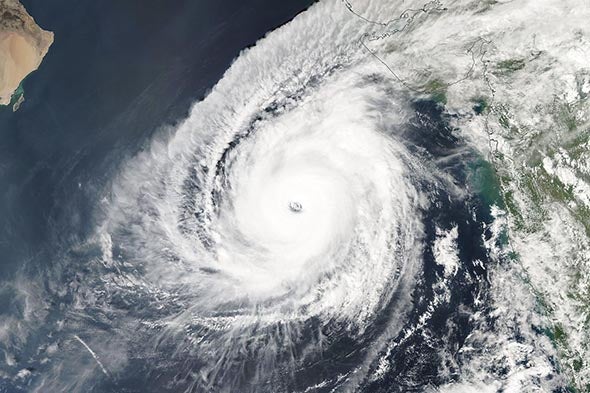Even as the world battles the COVID19 pandemic which has accounted for more than five million cases and over three lakh deaths, millions of people along the eastern coast of India, particularly West Bengal and Odisha are up against a foe that comes visiting without fail almost every year: the cyclone which this time goes by the name ‘Amphan’.
Amphan has already forced evacuation of around 4.5 lakh people, including 1.20 lakh people from Odisha and 3.30 lakh people. The Government along with the National Disaster Management Authority has been making preparations to deal with the cyclone. The National Disaster Response Force has employed total 41 teams in the two states for providing relief and rescuing people during the cyclone, including 15 teams in Odisha and 19 teams in West Bengal.
The cyclone is an even bigger challenge coming as it does as the nation grapples with the outbreak of the COVID-19 pandemic. States throughout the Country have used their funds and resources during the lockdown in their attempts to contain the spread and ensuring healthcare and other essentials to their citizens.
World Health Organisation has defined a disaster as “any occurrence that causes damage, economic destruction, loss of human life, and deterioration of health and health services on a scale sufficient to warrant an extraordinary response from outside the affected community or area” India has faced several natural disasters in the past like the Bhuj earthquake, Orissa’s supercyclone of 1999, etc.
The Constitution of India makes it the responsibility of the States to provide immediate relief to victims during natural calamities. The Ninth Finance Commission had recommended setting up of a Calamity Relief Fund Scheme to finance the relief expenditure of States during natural calamities. This was replaced by the National Calamity Contingency Fund. This fund was renamed as National Disaster Response Fund (NDRF) after enactment of the Disaster Management Act 2005.
Section 46 and Section 48 of the DM Act stipulate the constitution of NDRF at National level and State Disaster Response Fund at State level respectively. NDRF is the fund managed by Central Government for meeting expenses for emergency response, relief and rehabilitation during any disaster. It supplements the funds of the SDRF and facilitates relief during calamities. The Thirteenth Finance Commission, in 2010 had made provisions of funds for SDRF and guidelines were formed for administration of both NDRF and SDRF.
The State Disaster Response Fund is the primary fund available with State Governments to respond to notified disasters. The Central Government contributes 75% of SDRF allocation for general category States and Union Territories and 90% for special category States and UTs like the North-East States, Sikkim, Uttarakhand, Himachal Pradesh, Jammu and Kashmir. The amount contributed to the fund by the Central Government is done as recommended by the Finance Commission and the annual contribution is released in two equal instalments. It can be used only for meeting the expenditure for providing immediate relief to the victims. The Disasters covered under SDRF are Cyclone, drought, earthquake, fire, flood, tsunami, hailstorm, landslide, avalanche, cloudburst, pest attack, frost and cold waves. However, a State Government can use up to 10 percent of the funds available under the SDRF to provide immediate relief to the victims of natural disasters which are not included in the notified list of disasters subject to approval of the State Executive Authority
The Central Government had decided to treat COVID-19 as a notified disaster for provision of relief under SDRF, after it was declared a pandemic by WHO. The Disaster Management Division of the Government has been listing items and norms for which assistance can be provided under SDRF like, provision for temporary accommodation, food, clothing, medical care, for homeless people, migrant labourers, measures for quarantine , sample collection and screening, Procuring essential equipments, etc.
The Finance Ministry had released Rs 17,287 crore to states to enhance their financial resources during the COVID-19 crisis, out of which Rs 11,092 crore was towards State Disaster Response Mitigation Fund to all states. The Centre had approved an advance release of Rs 1,611 crore to Maharashtra to fight the disease when it had reported the highest number of Covid positive cases. Andhra Pradesh was allocated Rs 555 crore, Tamil Nadu was given Rs 510 crore, Uttarakhand was given Rs 468 crore and Assam was allocated Rs 386 crore.
The State of West Bengal was allocated an amount of Rs 505 crore to assist the State and the people during COVID, and now when its faced with yet another natural calamity, further assistance from Central Government may be required. In such calamities, funding the States do face a difficulty in funding even after allocation of funds. The NDRF through which the centre assists states when they face severe calamities is available only for disaster relief and not for mitigation or restoration, the States are often at a tough spot and have to deal with the restoration and mitigation on their own or look for alternate funding. Even though funds are allocated for disaster management to States on an yearly basis, both the NDRF and SDRF are non-lapsable funds, therefore they lapse if they are not utilised in that new financial year. The Union Home Secretary has however assured both the States of Odisha and West Bengal that if any assistance is required from the Centre , it will be provided.


